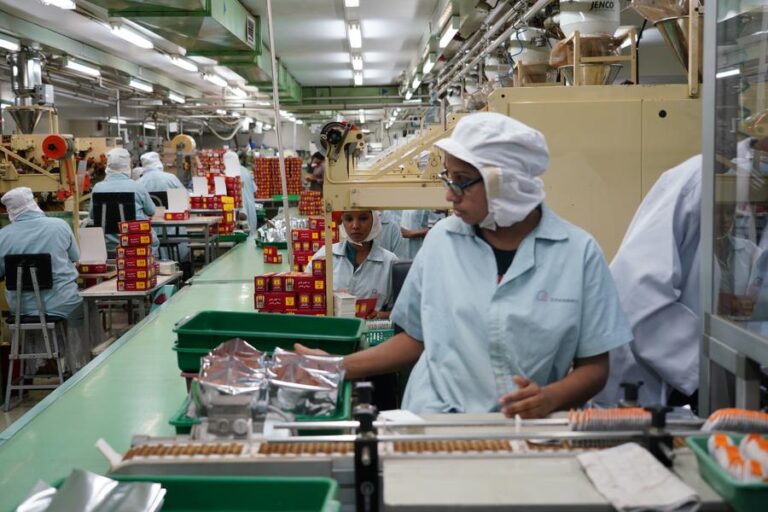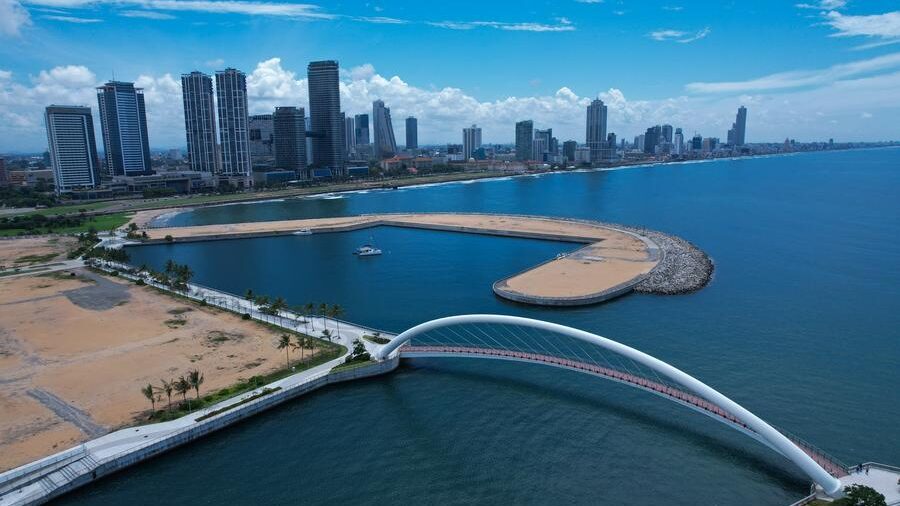A view of the Port City Colombo, Sri Lanka, October 26, 2024. /Xinhua
Staggering U.S. tariffs a wake-up call for Sri Lanka
by Yasiru Ranaraja
Editor’s note: Yasiru Ranaraja, a special commentator on current affairs for CGTN, is a researcher on maritime affairs and expert on Belt and Road Initiative development. He is also the founding director of the Belt Road Initiative Sri Lanka (BRISL), an international development organization and think tank in Sri Lanka. The article reflects the author’s views and not necessarily those of CGTN.
The recent decision by the United States to impose a staggering 54 percent total tariff, comprising 44 percent specific import duty on Sri Lankan exports and a 10 percent base tariff rate on all exports to the U.S., could not have come at a more sensitive time for the island nation, which is still recovering from its worst economic crisis in decades.
The U.S., as Sri Lanka’s single largest export destination, accounts for approximately $3 billion of the country’s $13 billion in total exports, primarily textiles and apparel. In contrast, Sri Lanka imports only about $368 million in American goods, resulting in a trade surplus of roughly $3 billion. However, with the new tariff regime in place, that advantage may soon be rendered irrelevant.
The hardest-hit sector in Sri Lanka will likely be apparel, which directly employs over 360,000 workers and supports another million indirectly. For many rural families, especially women-led households, these jobs serve as the backbone of daily survival, offering one of the few pathways to financial stability. A tariff of this magnitude threatens not only to erode trade competitiveness but also to drag entire communities deeper into economic insecurity. In an industry where margins are already thin, buyers may shift their orders elsewhere unless Sri Lankan producers either slash costs or absorb the tariff burden, neither of which is a viable long-term solution.

Staff members work on the production line of organic tea at Stassen Exports Private Limited in Colombo, Sri Lanka, Oct. 28, 2019. /Xinhua
The rationale behind this tariff policy stems from America’s broader shift toward protectionism and its internal economic mismanagement, a trend that gained momentum during the Trump administration. Tariff walls were created under the pretext of safeguarding American industry and reducing dependency on China.
Countries like Vietnam, Bangladesh, Cambodia, Laos, Madagascar, Myanmar and Sri Lanka have increasingly found themselves targeted. The intended outcome is clear: By taxing imports from alternative suppliers, U.S. firms would be forced to relocate production domestically. Yet this theory ignores some hard economic realities.
While the U.S. accounted for over 60 percent of global manufacturing in the 1960s, that share has now shrunk to just 15 percent. In comparison, China now accounts around 34 percent of global manufacturing output. Replacing that scale with domestic production is neither realistic nor achievable, certainly not within the next four years.
Moreover, tariffs don’t just hurt foreign producers, they raise prices for American consumers as well. U.S. households, already struggling with inflation hovering around 3.2 percent, are now expected to pay more for essential goods. This additional burden will hit low- and middle-income Americans the hardest, while doing little to actually stimulate significant new domestic manufacturing.
What makes this all the more troubling is that such protectionist moves contradict the trade system the U.S. once proudly led. From the Bretton Woods system to the General Agreement on Tariffs and Trade and the World Trade Organization, America has historically positioned itself as a defender of free markets, open trade, multilateralism and global economic cooperation. The tariff war undermines that legacy, replacing long-term global stability with short-term political maneuvering.
For Sri Lanka, this development should trigger a serious reassessment of its trade strategy. For too long, the country has depended heavily on Western markets while failing to diversify both its trade partners and product offerings. The U.S. Generalized System of Preferences (GSP), which once granted duty-free access to over 3,500 product categories, now hangs in the balance. At the same time, the European Union’s GSP+ facility is set to expire next year. Despite these looming challenges, Sri Lanka has yet to aggressively pursue alternative markets or expand regional trade access.
The time to pivot eastward was 10 years ago. Still, with Asia emerging as the world’s new economic center of gravity, regional integration is not just desirable, it is imperative. Platforms like the Regional Comprehensive Economic Partnership, the Belt and Road Initiative and bilateral trade agreements with countries such as China, India and those in ASEAN, should form the backbone of Sri Lanka’s new economic strategy. Moreover, markets in other regions in close proximity to Sri Lanka as Central Asian nations, West Asian nations and even in the East Asian region should be interlined towards a greater Eurasian trade model.
In Sri Lanka, flagship national projects like the Colombo Port City, the Hambantota Industrial Zone and the Northern Port development must be repositioned not merely as Western-facing investments, but as core nodes in dynamic Asian supply chains. Furthermore, China’s strategic preparations for a tariff war offer valuable lessons. Rather than resisting global shifts, China strengthened its resilience by investing in domestic demand, expanding regional trade networks and leading global infrastructure initiatives. Similarly, Sri Lanka must aim to be more than a passive player caught between great powers; it must emerge as a smart, agile connector in a multipolar global economy. As an island state with an about $80 billion economy, Sri Lanka can no longer afford to rely on a single region or product category for more than 15 percent of its export earnings. That kind of dependency is simply too risky.
On a more optimistic note, this tariff shock could serve as a timely wake-up call, not just about the pitfalls of American protectionism, but about the critical need for Sri Lanka to pursue strategic trade diversification. If the mantra in Washington remains “Make America great again,” this time it may end up breaking more than it builds.

Yasiru Ranaraja is a seasoned researcher specializing in maritime affairs and expertise in Belt and Road Initiative (BRI) development. He holds a degree from Dalian Maritime University and earned his LL.M from Ocean University of China in 2019. Yasiru co-founded Belt & Road Initiative Sri Lanka (BRISL), an international development organization based in Sri Lanka, where he currently serves as the founding director. For inquiries, reach out via email at yasiru.ranaraja@gmail.com or Twitter: @YRanaraja


